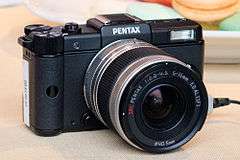Pentax Q
The Pentax Q is a mirrorless interchangeable-lens camera introduced by Pentax on June 23, 2011.
 Pentax Q with zoom lens | |
| Overview | |
|---|---|
| Maker | Pentax |
| Type | Mirrorless |
| Lens | |
| Lens mount | Pentax Q-mount, bayonet, stainless steel mount |
| Sensor/medium | |
| Image sensor type | BSI-CMOS sensor |
| Image sensor size | 1/2.3″ (1/1.7″ for Q7 and Q-S1), 12.4 megapixel |
| Maximum resolution | 4:3 native: 4000 x 3000, 3456x2592, 2688x2016, 1920x1440 |
| ASA/ISO range | 125-6400 (Q, Q10), 100-12800 (Q7, Q-S1) |
| Recording medium | SD, SDHC, SDXC |
| Focusing | |
| Focus | autofocus with manual override |
| Flash | |
| Flash | built-in: P-TTL, popup extension, GN 7m, 1/2000 s sync (leaf shutter), 1/13 s (electronic); external P-TTL, 1/250 s sync |
| Shutter | |
| Frame rate | 5-frame burst; 1.5fps sustained |
| Shutter | electronic, leaf shutter in lens where applicable |
| Shutter speeds | 30 s to 1/2000 s mechanical; 2 s to 1/8000 s electronic |
| Viewfinder | |
| Viewfinder | optional optical suitable for 8.5 mm f/1.9 lens |
| Image processing | |
| Custom WB | auto, CTE, manual set; presets: daylight, shade, cloudy, fluorescent (D, N, W, L), tungsten, flash; fine adjustment available in all modes |
| General | |
| Video/movie recording | 1920x1080 30fps, 1280x720 30fps, 640x480 30fps |
| Rear LCD monitor | 360x320x4 luminance-R-G-B HVGA; color LCD |
| Battery | proprietary, rechargeable li-ion battery, Pentax D-LI68 |
| Data Port(s) | USB 2.0 |
| Body composition or special features | mechanical sensor-shift image stabilization (photography); electronic image stabilization (video) |
| Dimensions | 98 x 57 x 31 mm (3.86 x 2.24 x 1.22") |
| Weight | 180 g (0.40 lb / 6.35 oz) |
| Made in | Philippines |
Characteristics
Introduced as "The world's smallest interchangeable lens system camera…"[1] The Pentax Q system is composed of four bodies (Q, Q10, Q-7, Q-S1) and eight lenses: the 01 prime normal, the 02 wide-tele zoom, 03 fish-eye, the 04 "toy" wide angle, the 05 "toy" telephoto, the 06 telephoto zoom, the 07 "mount shield" lens, and the 08 ultra-wide zoom. The zooms and prime normal lenses have leaf shutters (with built-in neutral density filters) and sync with flash up to 1/2000 of a second. The other lenses use the camera's electronic shutter. The 09 macro lens was prototyped but never released. Modern Pentax K mount lenses can be used on the Q with an adapter that has a mechanical shutter. Other adapted lenses use the electronic shutter.
The camera's small sensor size (1/2.3") means that the Q has a crop factor of 5.6× (compared to full-frame 35mm cameras), as well as a short flange focal distance (FFD). With the 5.6× crop factor, a 100mm macro lens (for example) results in a 35mm equivalent field of view (FOV) of a 560mm telephoto. An additional implication of the 5.6× crop factor and associated optics is that depth of field (DOF) is increased proportionally for a given aperture setting (in comparison to the 35mm equivalent DOF at the same aperture). This means that in some applications the small Pentax Q sensor offers an advantage over larger formats. This also allows the Pentax Q lenses to be proportionally smaller than lenses designed for larger formats.
The short FFD of the Pentax Q enables it to accept manual focus lenses from many manufacturers (via adapters) including Nikon F, Leica M and 39M, Olympus OM, Canon FD, Minolta, M42 screw mount, C-Mount, D-Mount, Pentax K, and Pentax Auto 110.[2]
The Pentax Q has a wide range of digital effects and controls including High Dynamic Range (HDR), multiple scene modes, and a bokeh function which, when activated, can enable a pseudo shallow focus effect.
The camera is equipped with sensor-shift image stabilization technology to improve image quality at slow shutter speeds or when using telephoto lenses. It has a "focus peaking" function as well. Sensor shift and focus peaking functions also work with adapted lenses.
The Q7 and Q-S1 models have a larger sensor size (1/1.7") resulting in a crop factor of 4.6×.
References
- http://ricohimaging.com/products/q-series/
- "Lens Adapters | B&H Photo Video". Bhphotovideo.com. Retrieved 2013-06-16.